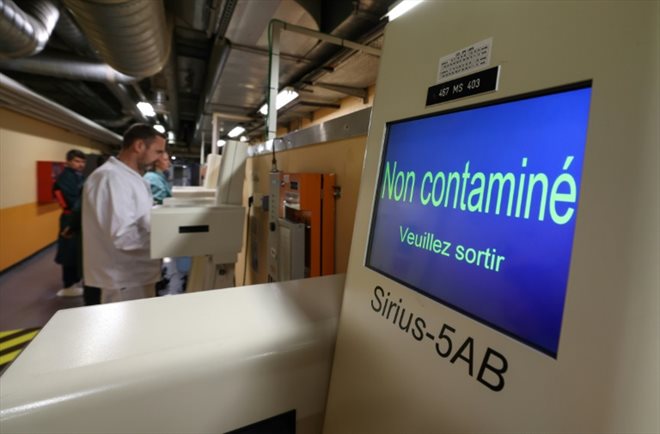The entrance to the Atalante unit of the research center of the Atomic Energy and Alternative Energies Commission (CEA), on September 19, 2023 in Marcoule, in Gard (AFP/Pascal GUYOT)
Silver, nickel, lithium, palladium, rhodium: all metals are in nature, but not only. In Marcoule (Gard), CEA researchers are recycling its nuclear know-how to extract rare metals from used batteries, wind turbines and solar panels.
A few days before the first summit on critical metals, organized Thursday in Paris by the International Energy Agency (IEA), the Atomic Energy and Alternative Energies Commission opened the doors of the Atomic Energy and Alternative Energies plant to the press. Marcoule being dismantled and converted into a research center.
“We are looking at how to store, convert, transport electricity and how to make the energy transition efficient,” explains Richard Laucournet, head of the new materials department at the CEA.
“But all electricity conversion devices require many of the 34 critical metals listed by the European Union,” he argues.
Hence the interest in recovering rare metals and magnets contained in the “urban mines” of the future that are today’s electrical equipment. With the aim of reusing them industrially, a crucial strategy for a country which has almost no mines and depends mainly on imports.
– “Without knowing” –
“In no case will this recycling allow France to become sovereign and independent” nevertheless warns Philippe Prené, circular economy manager for low-carbon energies at the CEA.

The research center of the Atomic Energy and Alternative Energies Commission (CEA), September 19, 2023 in Marcoule, in Gard (AFP/Pascal GUYOT)
According to his calculation, the recycling of metals could ensure around 35% of autonomy for Europe in batteries.
Many of the techniques used by Marcoule researchers to characterize or separate materials come from their know-how in atomic sciences.
“Nuclear has been able to achieve a circular economy for 70 years without knowing it, it’s called the fuel cycle,” says Mr. Prené, that is to say the reprocessing and reuse of nuclear fuel.
“Thanks to the simulation tools developed here, we can reprocess rare earths from magnets,” explains Richard Laucournet.
In one of the Atalante unit’s labs, remote manipulators work in front of sealed enclosures, using large pliers through a meter-thick window, cutting out irradiated fuel rods.
The alloy sections are placed in hot acid solutions, explains Nathalie Herlet, deputy head of the process research department. The metal dissolves. And can then be extracted via the use of organic solvents and decanters.

Technicians from the research center of the Atomic Energy and Alternative Energies Commission (CEA), September 19, 2023 in Marcoule, in Gard (AFP/Pascal GUYOT)
The process is suitable for recovering lithium, nickel, cobalt, and graphite from the “blackmass” resulting from the crushing of automobile electric battery cells.
The “molten salts” technique being developed at Marcoule will be useful both for the recycling of fuels from the announced future 4th generation reactors, and for valorizing rare earths such as neodymium from magnets, add the researchers.
These technologies are all the more useful since “there is no real magnet recycling sector” in the world, with the exception of production scrap in Asia, underlines Mr. Laucournet.
– “Supercritical fluids” –
In photovoltaics, a technique based on “super-critical fluids” is used.

The research center of the Atomic Energy and Alternative Energies Commission (CEA), September 19, 2023 in Marcoule, in Gard (AFP/Pascal GUYOT)
Carbon dioxide CO2 is used to detach and inflate solar panel cells, allowing the recovery of the silicon and silver contained therein.
In nuclear power, water “in a supercritical state”, which “enters the interior of matter”, has been qualified since 2015 to help remove radioactivity from metals in a liquid state, in the hope of manage radioactive waste one day, explains Ms. Herlet.
This process on which the CEA has been working for “more than 20 years” is used for the recycling of wind turbine blades.
Water at very high temperature and very high pressure “breaks” the polymer chains of the fiberglass or carbon composites that make up wind turbine blades and hydrogen tanks.

The research center of the Atomic Energy and Alternative Energies Commission (CEA), September 19, 2023 in Marcoule, in Gard (AFP/Pascal GUYOT)
In pure nuclear power, the CEA is also working on the possible recycling of part of the radioactive fission products destined to be vitrified and buried for eternity: the famous radioactive waste.
“They contain very rare and very expensive metals, generated by the nuclear reaction itself”, “platinoids such as palladium, rhodium or ruthenium” in particular, indicates Mr. Prené. “We started studies to extract them. It works,” he says.
“If we had authorization to recover rhodium and revalue it”, (…) this would make it possible to extract approximately 700 kg per year” of this metal, or “nearly 20% of world production” .
© 2023 AFP
Did you like this article ? Share it with your friends using the buttons below.




